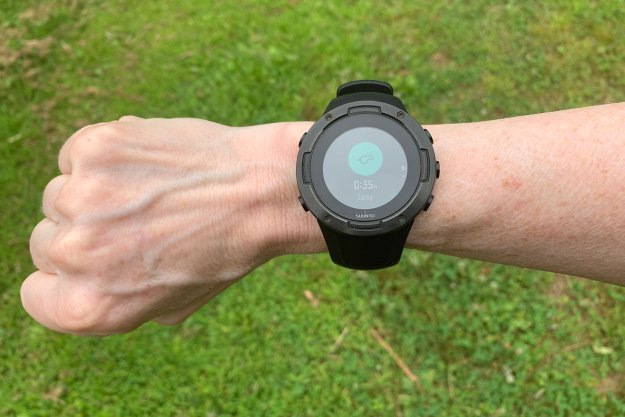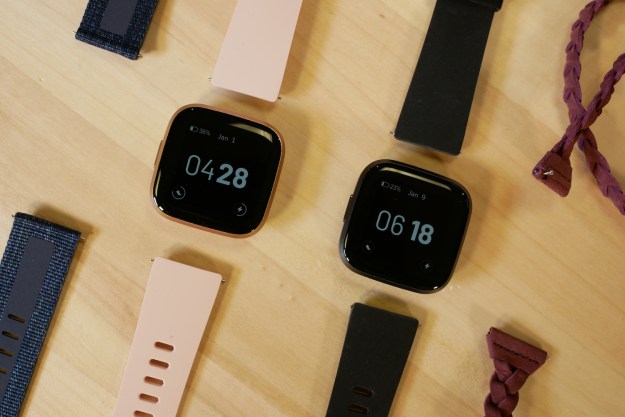
“The Suunto 5 wows with its feature list, but disappoints with uncomfortable design and a poor display.”
- Great battery life
- Rugged and durable casing
- Helpful fitness training plans
- Reasonably priced
- Shoddy glass over display, poor brightness and resolution
- Uncomfortable strap design
- Finicky heart rate monitoring
- No barometric altimeter
- Limited sleep tracking
Suunto is known for its rugged outdoor watches that can take a licking and keep on ticking. The company’s latest GPS watch, the Suunto 5, is no exception. It’s a rugged multi-sport watch you can confidently wear while mountain biking, rock scrambling, or trail running.
- Durable but flawed design
- Unintuitive interface
- Finicky heart rate monitoring
- Fitness training that meets your needs
- Sleep tracking could be better
- GPS goes beyond activity tracking
- Smartphone notifications
- Flexible battery life
- Suunto Flow App: Messy, but improving
- Price, availability, and warranty information
- Our Take
The Suunto 5 falls in the middle of the Finnish company’s lineup between the flagship Suunto 9 and the entry-level Suunto 3 Fitness. It offers a bit of everything from stress monitoring to high-end features like intelligent battery management and adaptive training. But it’s not all rainbows and unicorns, as there are a few significant flaws that detract from this otherwise capable GPS watch. Here’s what it’s like.
Durable but flawed design
The Suunto 5 falls into the multi-sport category, so it’s bigger than most casual fitness watches like the Fitbit Versa and heavier that your lightweight running watches like the Garmin Forerunner 245. It measures 46mm across the face, which puts it in the “big, but not obscenely big” category.
At 66 grams, it’s heavy, especially when compared to similar-sized watches like the 38.5-gram Forerunner 245 or the 55-gram Garmin Instinct. Despite its girth, I was comfortable wearing the Suunto 5 when exercising outside or at the gym. I wore it 24/7 for testing purposes, and I definitely felt the urge to take it off while at the office or during events out in town. It’s a watch you’ll only want to wear while exercising.
Like most Suunto watches, the Suunto 5 screams durability. The stainless steel bezel and glass fiber reinforced polycarbonate casing are rugged. I never worried about glancing a tree while running or mountain biking as I knew the casing and bezel could handle the impact — and it did. The buttons also are well-made: even when covered in dirt, mud, and sweat, they never jammed and were easy to press.
On the underside of the casing is the heart rate monitor which lies nearly flush with the casing. The charging port sits along the perimeter of the case next to the heart rate monitor. It’s not an ideal location as it quickly got clogged with sweat and dirt.
Though Suunto didn’t skimp on the casing and bezel, the Finnish company cut corners with the display on the Suunto 5. The glass covering the display scratches easily; after a few weeks of wearing the watch around the clock, I had several small scuffs on the display, even though I never fell hard or had a collision to cause them.
Like most Suunto watches, the Suunto 5 screams durability.
Another disappointment is the 218 x 218 resolution display. It suffers from a dim backlight that makes it near impossible to read in sunlight. It’s also small at 1.2 inches compared to the size of the watch (1.8-inches). The display is terribly poor, and I recommend you check out the Suunto 5 in person before shelling out $329 for it.
The Suunto 5 is equipped with a one-size-fits-all silicone band. The band is held by a metal clasp and has two sliders to hold the loose end in place. It feels secure on my wrist and I never worried about it breaking or unexpectedly falling off. But comfort is another story. The band has rigid lugs that connect the strap to the case, and while they are curved, these rigid pieces aren’t flexible and never comfortably fit my wrist. They caused the watch to slide awkwardly and got in the way while sleeping. On more than one occasion, I woke up in the middle of the night as the band was painfully digging into my wrist.
The Suunto 5 is available in a variety of colors including a black band with a black bezel, a white band with a silver bezel, a burgundy band with a copper bezel and my personal favorite — a graphite band with a copper bezel. The latter two colors are a nice change from the standard black and white watches. They have a professional look that doesn’t scream “rugged fitness watch” on your wrist.
While this is undeniably a rugged watch, the poor display, shoddy glass quality, and uncomfortable fit ruined my experience of wearing the Suunto 5.
Unintuitive interface
Though Suunto added a touchscreen to the Suunto 9, the company stuck with the traditional five button layout for the Suunto 5. Each button has a dedicated function that lets you view your notifications, access a shortcuts menu, cycle through your daily stats and more.

Sadly, the watch controls are not intuitive and there are no labels on the bezel to indicate their functions. I did finally get accustomed to the interface, but there is a big learning curve, especially if you are switching from another brand of device. Once you learn the functions of each respective button, using the watch becomes a lot easier.
Finicky heart rate monitoring
Underneath the rugged exterior of the Suunto 5 is a robust fitness tracker with features that are borrowed both from the Suunto 3 fitness watch and the Suunto 9 adventure watch. It’s a multi-sport watch with support for more thna 80 different sport modes. You can add up to eight sports on the watch and customize each one with the data fields you want.
Not only does it handle land-based activities, the Suunto 5 is water resistant down to 50-meters so you can use it for both pool laps and open water swimming. Like most GPS watches, open water swimming is hampered by the water, which interferes with the GPS signal.
Suunto’s adaptive training plans are perfect for those looking to maintain their fitness.
The Suunto 5 is equipped with an optical heart rate monitor that is finicky at times. Like most wrist-based optical heart rate monitors, the Suunto 5 takes several minutes to normalize when you start an activity and lags slightly behind your existing heart rate when you change your effort. Though average heart rate during an activity was accurate, the max heart rate during an exercise and the heart rate zones tended to be higher than other devices such as the Forerunner 245 and the Polar Ignite.
The 24/7 heart rate monitoring also jumps wildly when you move your arm, spiking 20 points higher than the other fitness watches I was testing. Part of this inaccuracy might be the result of the ill-fitting band, which makes it difficult to get a comfortable and snug fit.
Fitness training that meets your needs
One of the best fitness features in the Suunto 5 is personalized and adaptive training plans. The watch lets you choose whether you want to “Maintain”, “Boost,” or “Improve” your fitness activity, and generates 7-day training plans. The plan mixes hard and easy days so you never overdo it, and each session is assigned a time and an intensity level.
When you start an activity, you can choose to complete the workout plan or ignore it and do your own thing. If you follow the plan, the watch tracks your intensity and provides real-time guidance to keep you exercising at the correct pace.

I found the training plans to be geared for improving your fitness at an entry-level instead of pushing you hard. After not running for several weeks due to surgery, the training plan was perfect for my return to working out. It detected I was inactive and adapted the training to ease me back into running. After a few weeks of training, I was back to running 5 to 6 miles regularly.
Besides performance tracking, the Suunto 5 is packed with FirstBeat-style metrics like stress, body resources, and fitness level (VO2Max). Similar to Garmin’s body battery, body resource measures your physical activity, stress level, sleep, and recovery. It blends all those metrics together and spits out a percentage that estimates your current energy reserves. Not all these metrics are available on the flagship Suunto 9, positioning the Suunto 5 for the athlete who wants to track all facets of their health.
Sleep tracking could be better
Suunto keeps it simple with sleep tracking, providing a sleep score based on the amount and quality of your sleep. You can use this easy-to-interpret value to track your sleep over time just like you would your running pace or VO2Max. The sleep score also is used in other metrics such as body resources and recovery time.
Sleep data is sent each morning to the Suunto app, but the analysis is limited compared to Fitbit and Garmin. You can only view your total sleep time, awake time, deep sleep time, overnight heart rate, and sleep score. There is no hourly graph of your sleep nor any further breakdown of your rest into REM sleep or light sleep.

The Suunto 5 accurately measured when I fell asleep, but struggled sometimes to detect when I woke up. Every once in a while, it thought I was waking up when I was just rolling over to hit the snooze button. Most of the time, the watch ended my sleep when I got out of bed and greeted me with “Good Morning” as I was walking out of my bedroom. But the watch didn’t catch moments like when a dog barked or an unexpected alert woke me up and interrupted my sleep.
GPS goes beyond activity tracking
The Suunto 5 has built-in GPS, GLONASS, GALILEO, and QZSS satellite support that can be used for activity tracking and navigation. It records an activity in progress and stores that GPS data so you can compare your performance then next time you run or bike that area. GPS accuracy is spot on, even in the woods.
The watch also supports using the GPS for navigation, allowing you to travel to a point of interest (POI) or follow a route you’ve added to the watch. There is no barometric altimeter, but the watch does calculate the elevation and provides an elevation profile, both of which are generated using GPS data.
Smartphone notifications
The Suunto 5 connects to your
My only gripe was connectivity. When I walked away from my phone and returned, the watch would reconnect and re-download all the notifications on my phone. The constant beeping of these notifications is annoying at home and disruptive in public.
Flexible battery life
Battery life is a big selling point that sets the Suunto 5 apart from its competition. Suunto’s secret sauce is its trio of power-saving battery modes — Performance, Endurance and Ultra — all three of which debuted on the Suunto 9. Each power mode tweaks the watch settings by turning off features to get as much power out of the battery as necessary. The watch is always monitoring the battery levels reminding you to charge your watch before a workout or prompting you to change the battery mode mid-workout so you can continue tracking your activity.
These intelligent battery modes come in handy as the Suunto 5 burns through the battery when 24/7 heart rate tracking is enabled. Instead of the promised 14 days of battery life, I averaged about 7-8 days with heart-rate monitoring and notifications enabled. I do get a lot of notifications so your mileage may vary.
When I was hiking with full GPS tracking and heart rate monitoring, the battery lasted approximately 15 hours. When I used Endurance mode to dial down the GPS tracking and heart-rate monitoring, I reached 35 hours, short of the promised 40 hours, but still better than most other smartwatches.
Suunto Flow App: Messy, but improving
Suunto’s app ecosystem is still a hot mess. The company is gradually moving away from its Movescount platform and transitioning all its devices to its new Suunto app platform. Don’t expect to use Movescount with the Suunto 5, as the watch syncs exclusively with the new Suunto app. Existing Suunto owners will have to move all their Movescount data over to the new Suunto app or just start over with their new Suunto 5 app.
The good news is that the new Suunto app is improving steadily. It has a clean interface that is thoughtfully organized and easy to use. You can view your steps, calories burned, and sleep with daily, weekly, monthly, and yearly breakdowns. You also can view all your activities and analysis here.
The app stores a wealth of information that is geared toward the athlete in training who wants to track their performance. It’s not as robust as Garmin’s Connect platform, which has better data analysis and number crunching.
The Suunto app can sync its data to the Sports Tracker web app, which is taking the place of Movescount. Sports Tracker works for casual athletes, but performance hounds who want to dive deep into metrics will be disappointed.
If you prefer using third-party services, you can export your training and health data to apps like Strava, Training Peaks, Apple Health, and more.
Price, availability, and warranty information
The Suunto 5 is available now for $329 from Suunto’s website and other retailers.
The company offers a two-year limited warranty on the Suunto 5 that covers defects in materials or workmanship. Suunto will fix any defects free of charge by either repairing the watch, replacing it, or refunding the original cost.
Our Take
The Suunto 5 is a rock-solid watch that delivers on training and multi-sport activity tracking, as well as strong battery life. But Suunto cut corners with the display and glass quality, making it prone to scratches and difficult to read in the sunlight. It’s also not very comfortable to wear, ruining the experience of it on the wrist.
Is there a better alternative?
The Suunto 5 packs a ton of features into an affordable multi-sport watch, but the dim display may be a deal breaker. A solid alternative is the Garmin Instinct, which has a similar rugged design with features that are geared for outdoor adventures. Multi-sport athletes who mostly run should consider the lightweight Forerunner 245 or the long-lasting Coros Apex.
Check out our guide to the best fitness trackers for more.
How long will it last?
The Suunto 5 is built like a tank and should last for several years — as long as you use a screen protector to protect the glass from scratches. Suunto slowly and steadily updates its devices and its app ecosystem and I expect they will do the same for the Suunto 5.
Should you buy it?
No, the display brightness, comfort, and glass quality are deal breakers for me.
Editors' Recommendations
- The app for your Garmin wearable is getting a huge overhaul
- Xiaomi’s newest wearables may make you want to ditch your Apple Watch
- Oppo’s latest Apple Watch clone has an important spec under the hood
- Fitbit Charge 5 adds sweat-based stress sensor, rounded design
- The best running watches for 2022













